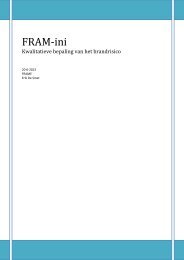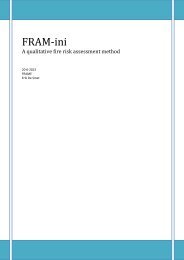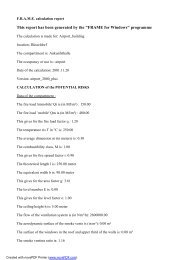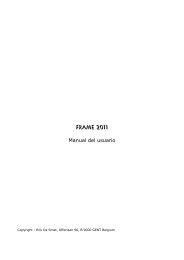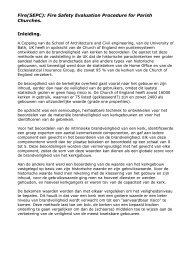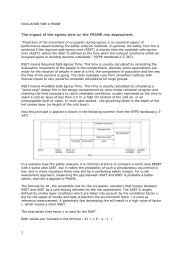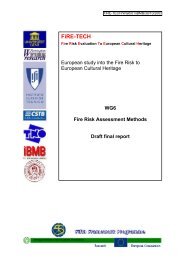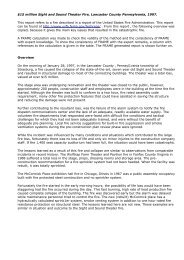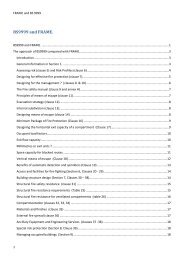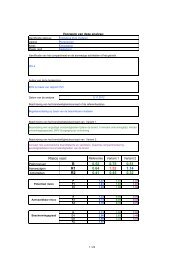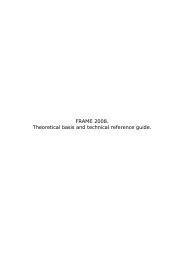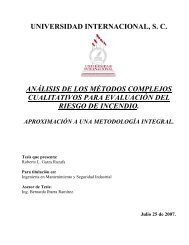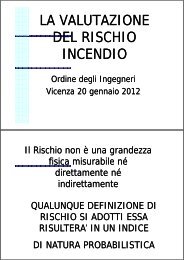FRAME Calculation examples book. - FRAME Fire Risk Assessment ...
FRAME Calculation examples book. - FRAME Fire Risk Assessment ...
FRAME Calculation examples book. - FRAME Fire Risk Assessment ...
You also want an ePaper? Increase the reach of your titles
YUMPU automatically turns print PDFs into web optimized ePapers that Google loves.
F.R.A.M.E.<br />
are an indication that property damage will be limited, but that it is likely that a serious fire<br />
would make victims.<br />
Case study 5. Honda Spare parts centre, Ghent (BE), October 29 th 1987.<br />
This modern spare parts warehouse of the renowned car manufacturer was located at 10 min.<br />
from my home. On that morning, it burned completely down in about 4 hours. The offices, the<br />
boiler house and the electrical substation, which were separated from the main building by<br />
firewalls, were saved. The people in the building were informed by the fire detection and alarm<br />
system and could all leave the building in due time. There were no victims. It took the<br />
company about two years to rebuild a new (overprotected) warehouse. During that time the<br />
company had to distribute its operations over several rented warehouses in the area.<br />
The origin of the fire remains unknown. A defective lighting fixture in the rack storage has<br />
been indicated as the most probable cause. This 31.500 m² large warehouse was used as<br />
European spare parts distribution centre of a car manufacturer. Spare parts for all current<br />
types were stored here, and orders from garages and stockists were handled here and<br />
dispatched within 24 hours. In the building there was 6.7 m high rack storage and order<br />
picking areas. Some 160 persons worked in the building.<br />
The building had a steel structure with light concrete external walls. Roof height was 7.5 m.<br />
<strong>Fire</strong> protection consisted of an automatic fire detection system, smoke vents at a ratio of 2 %<br />
of the floor area, extinguishers and hand hoses. The plant had a first intervention team, the<br />
local fire brigade is a full professional fire brigade at 10 min distance from the plant. The plant<br />
had no independent water supply, but is located at +/- 300 m from the sea canal Ghent-<br />
Terneuzen.<br />
This case study was first documented in the technical file DT73 évaluation des risques, (1988)<br />
of ANPI Belgium that explained the <strong>FRAME</strong> version 1. The <strong>Risk</strong> calculation gave an initial risk<br />
Ro =10.24, which means that compartimentation will be needed to reduce the property risk to<br />
an acceptable level. The calculated values for this situation were :<br />
R = 5.95 , R1 = 0.47, R2 = 1.79<br />
These results mean that a total loss could be expected, without victims (R1 is OK) but also<br />
with serious business interruption consequences. AND THAT IS WHAT HAPPENED !<br />
Major factors that contributed to this situation:<br />
-very large compartment g =5.13<br />
- high fire load q = 2.03<br />
- water supply not immediately available W = 0.66<br />
The case study was recalculated with <strong>FRAME</strong> version 2 , and because of the changes in the<br />
factor t formula, slightly different results were obtained:<br />
R = 6.63, R1 = 0.45 and R2=1.98. The conclusions are the same.<br />
10



